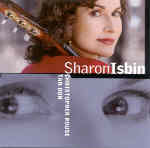Guitarist Sharon Isbin never has been afraid of new works; indeed, she has commissioned and premiered more new concertos than any other guitarist and has presented many new solo and chamber works as well. Her audacious spirit–and her tremendous musicality–is on fine display on this disc, which couples American composer Christopher Rouse’s Concert de Gaudí with Tan Dun’s Concerto for Guitar and Orchestra (Yi2). Why pair these two works? For starters, there’s the enormous palette of colors that each composer conjures. Rouse’s work cites the tonalities and rhythms of Spanish flamenco (and the title is a nod to Spanish architect Antoní Gaudí), but the brassy slides and exuberance is all Rouse. (His voice here is as unmistakably distinct as in his Trombone Concerto and Der Gerettete Alberich, written for percussionist Evelyn Glennie.) The overarching feeling, though, is one of dream-states and fantasy, where images shift hazily into one another and notes and chords bend and curve into new contours.
Tan Dun’s concerto is also significantly shaped by the forces of culture and history. Here though, the references are to Chinese traditional music, and most importantly the plucked lute called a pipa (or p’i-p’a). Like the guitar, the pipa is fretted, and Tan Dun treats the guitar much as he would the pipa itself. Though the composer works in an occasional flamenco/Spanish rhythm (particularly in the violent Andante agitato), his clearer cultural reference is to Chinese classicism.
Isbin herself is a dazzler; her work as a technician is top notch. Even more importantly, she possesses an outstanding sense of color and understanding of the world of textures available to her as a master guitarist. Her crisp articulation also is remarkable, perhaps reflecting the influence of her former teacher, the celebrated keyboardist and Bach expert Rosalyn Tureck. It’s hard to judge much of the contributions of the Lisbon-based Gulbenkian Orchestra, or even those of conductor Muhai Tang, who seems to be pretty much following Isbin’s lead. The sonic quality of the recording is sharply divided; Isbin is miked crisply and brightly but the orchestra is distant, dark, and dim.
































